Fire Resilience Evaluation of a Historic University Building in China
Abstract
1. Introduction
2. Study Area
3. Methodology
3.1. Improved Delphi Method
3.1.1. Calculate Expert Activism Coefficient
3.1.2. Calculate the Concentration of Expert Opinions
3.1.3. Calculate Expert Authority
3.1.4. Calculate the Degree of Expert Coordination
3.2. ISM
3.2.1. Establish the Factor Set S
3.2.2. Establish the Adjacency Matrix A
3.2.3. Establish the Reachability Matrix M
3.2.4. Regional Division
3.2.5. Hierarchical Division
3.3. ANP Method
3.3.1. Constructing the Network Structure of Influential Factors
3.3.2. Establishing the Judgment Matrix
3.3.3. Supermatrix of the ANP Network Structure
- Constructing a supermatrix:
- 2.
- Weighting the supermatrix:
- 3.
- Finding the limit of the weighted supermatrix:
3.3.4. Making Decisions Based on the Results
4. Results
4.1. Improved Delphi Method Results
4.1.1. Expert Positivity Coefficient
4.1.2. Concentration of Expert Opinions
4.1.3. Expert Authority
4.1.4. Expert Coordination Degree
4.2. ISM Results
4.2.1. The Result of Establishing Factor Set S
4.2.2. Establish Adjacency Matrix
4.2.3. Calculate the Reachability Matrix
4.3. ANP Results
4.3.1. Unweighted Supermatrix of Eight Historic Buildings
4.3.2. Weighted Supermatrix of Eight Historic Buildings
4.3.3. Extreme Weighted Supermatrix of Eight Historic Buildings
4.3.4. Weights of Factors Influencing the Fire Resilience of Eight Historic Buildings
5. Discussion
6. Conclusions
- (1)
- The IDIA model for evaluating the fire resilience of historic university buildings constructed in this study enriches the research content in the field of fire resilience of historic university buildings. The improved Delphi method makes the research data source more accessible and objective. Based on the ANP as a model for evaluating and ranking the fire resilience of historic university buildings, the ISM was introduced to further optimize the ANP model’s relationship judgment process. By determining the direct influence relationships between factors and using a reachability matrix to identify all indirect influence relationships between factors, the relationship judgment results between factors are more accurate, improving the effectiveness of the ANP model. Combined with the opinions of the expert panel, by comparing the relative importance of all relevant factors, a priority ranking of the fire resilience of historic university buildings is obtained, providing a management basis for decision makers. Furthermore, while ranking the options, key factors influencing the fire resilience of historic university buildings can be identified, which can serve as auxiliary advice to help management control management direction.
- (2)
- The ISM analysis method was used to sort out the factors affecting the fire resilience of historical buildings in universities, and the evaluation index system was divided into four layers. Among them, S3, S8, S11, S14, S15, and S16 were identified as direct surface factors, that is, these indicators will directly affect the fire resilience of historic buildings in universities, and belong to the upper layer of the ISM hierarchy; factors S4, S6, S7, and S12, and S2, S5, and S13 belong to the second and third layers, respectively, and are middle-level indirect factors; S1 and S9 are defined as deep-level basic factors, belonging to the fourth layer of the ISM structure, and are the basic factors affecting the fire resilience of historic buildings in universities.
- (3)
- The higher the indicator weight, the greater its impact. The maximum weight varies slightly for each building. For the administration buildings, Eastpin Building No. 1, and Eastpin Building No. 3, the most heavily weighted indicator is fire prevention awareness (S10), with maximum weights of 0.200, 0.237, and 0.163, indicating that this indicator is the most important influencing fire resilience. For the auditorium, the most heavily weighted indicator is the fire water supply system (S12), with a weight of 0.136, indicating that this indicator is the most important influencing fire resilience. For Westpin Building No. 1, Westpin Building No. 2, Westpin Building No. 3, and Eastpin Building No. 2, the most heavily weighted indicator is the fire resistance level (S1), with maximum weights of 0.201, 0.131, 0.183, and 0.223, indicating that this indicator is the most important influencing fire resilience. Through calculation and analysis, it was found that fire resistance level (S1), fire prevention awareness (S10) and the fire water supply system (S12) play a dominant role in the fire resilience of historic university buildings in China, with the highest weight and the greatest impact.
Author Contributions
Funding
Institutional Review Board Statement
Informed Consent Statement
Data Availability Statement
Acknowledgments
Conflicts of Interest
Appendix A. Questionnaire for Screening Factors Affecting Fire Resilience of Historic University Buildings
Appendix A.1
- Dear Experts,
- 1.
- Educational backgroundA. PhD B. Master C. Bachelor D. Associate degree or below
- 2.
- Type of organizationA. University or research institute B. Fire department C. Historical build ing preservation practitioner D. Other organization
- 3.
- Years of experienceA. More than 10 years B. 5–10 years C. 2–5 years D. Less than 2 years
- 4.
- Job titleA. Professor or Senior Professor B. Associate Professor or Associate Senior Professor C. Lecturer or Engineer D. Teaching Assistant or Assistant Engineer
| Evaluation Indicators | Importance | Expert Revision Opinions | ||||
|---|---|---|---|---|---|---|
| 5 | 4 | 3 | 2 | 1 | ||
| Fire resistance level | ||||||
| Fire load | ||||||
| Smoke-proof partitions | ||||||
| Fire compartment | ||||||
| Fire prevention planning | ||||||
| Fire hazard inspection | ||||||
| Transportation network | ||||||
| population density | ||||||
| Fire emergency drill | ||||||
| Firefighting facility maintenance | ||||||
| Evacuation capacity | ||||||
| Firefighting expenses | ||||||
| Fire extinguishing capability | ||||||
| Fire prevention awareness | ||||||
| Fire education | ||||||
| Fire water supply system | ||||||
| Smoke exhaust system | ||||||
| Lightning protection equipment | ||||||
| Fire alarm | ||||||
| Mobile fire extinguishing equipment | ||||||
Appendix A.2
| Item Familiarity | The Main Basis and Influence of Item Judgment | |||||||||||||||
|---|---|---|---|---|---|---|---|---|---|---|---|---|---|---|---|---|
| A | B | C | D | E | Practical experience | Theoretical analysis | Domestic and foreign information | Intuition | ||||||||
| L | M | S | L | M | S | L | M | S | L | M | S | |||||
Appendix B. Questionnaire for Screening Factors Affecting Fire Resilience of Historic University Buildings
Appendix B.1
- Dear Experts,
- 1.
- Educational backgroundA. PhD B. Master C. Bachelor D. Associate degree or below
- 2.
- Type of organizationA. University or research institute B. Fire department C. Historical build ing preservation practitioner D. Other organization
- 3.
- Years of experienceA. More than 10 years B. 5–10 years C. 2–5 years D. Less than 2 years
- 4.
- Job titleA. Professor or Senior Professor B. Associate Professor or Associate Senior Professor C. Lecturer or Engineer D. Teaching Assistant or Assistant Engineer
| Evaluation Indicators | Importance | ||||
|---|---|---|---|---|---|
| 5 | 4 | 3 | 2 | 1 | |
| Fire resistance rating | |||||
| Fire load | |||||
| Fire compartment | |||||
| Fire prevention planning | |||||
| Fire hazard inspection | |||||
| Fire emergency drill | |||||
| Firefighting facility maintenance | |||||
| Evacuation Capacity | |||||
| Fire extinguishing capability | |||||
| Fire prevention awareness | |||||
| Fire Education | |||||
| Fire water supply system | |||||
| Smoke exhaust system | |||||
| Lightning protection equipment | |||||
| Fire alarm system | |||||
| Mobile fire extinguishing equipment | |||||
| Notes | |||||
Appendix B.2
| Item Familiarity | The Main Basis and Influence of Item Judgment | |||||||||||||||
|---|---|---|---|---|---|---|---|---|---|---|---|---|---|---|---|---|
| A | B | C | D | E | Practical experience | Theoretical analysis | Domestic and foreign information | Intuition | ||||||||
| L | M | S | L | M | S | L | M | S | L | M | S | |||||
References
- Garcia-Castillo, E.; Paya-Zaforteza, I.; Hospitaler, A. Fire in heritage and historic buildings, a major challenge for the 21st century. Dev. Built Environ. 2023, 13, 100102. [Google Scholar] [CrossRef]
- Kapucu, N.; Khosa, S. Disaster resiliency and culture of preparedness for university and college campuses. Adm. Soc. 2013, 45, 3–37. [Google Scholar] [CrossRef]
- Chou, J.S.; Ongkowijoyo, C.S. Hybrid decision-making method for assessing interdependency and priority of critical infrastructure. Int. J. Disaster Risk Reduct. 2019, 39, 101134. [Google Scholar] [CrossRef]
- Wang, S.; Huang, X. A Review on Higher Education of Fire Safety in China. Fire Technol. 2024, 60, 757–816. [Google Scholar] [CrossRef]
- Xiahou, X.; Chen, J.; Zhao, B.; Yan, Z.; Cui, P.; Li, Q.; Yu, Z. Research on safety resilience evaluation model of data center physical infrastructure: An ANP-based approach. Buildings 2022, 12, 1911. [Google Scholar] [CrossRef]
- Torres-González, M.; Prieto, A.J.; Alejandre, F.J.; Blasco-Lopez, F.J. Digital management focused on the preventive maintenance of World Heritage Sites. Autom. Constr. 2021, 129, 103813. [Google Scholar] [CrossRef]
- Himoto, K.; Sawada, Y.; Ohmiya, Y. Quantifying fire resilience of buildings considering the impact of water damage accompanied by fire extinguishment. Reliab. Eng. Syst. Saf. 2024, 243, 109858. [Google Scholar] [CrossRef]
- Huang, Y.H. The use of parallel computing to accelerate fire simulations for cultural heritage buildings. Sustainability 2020, 12, 10005. [Google Scholar] [CrossRef]
- Prieto, A.J.; Verichev, K.; Carpio, M. Heritage, resilience and climate change: A fuzzy logic application in timber-framed masonry buildings in Valparaíso, Chile. Build. Environ. 2020, 174, 106657. [Google Scholar] [CrossRef]
- Himoto, K. Conceptual framework for quantifying fire resilience—A new perspective on fire safety performance of buildings. Fire Saf. J. 2021, 120, 103052. [Google Scholar] [CrossRef]
- Torero, J.L. Fire Safety of Historical Buildings: Principles and Methodological Approach. Int. J. Archit. Herit. 2019, 13, 926–940. [Google Scholar] [CrossRef]
- Chen, J.; Ding, L.; Ji, J.; Zhu, J. A combined method to build Bayesian network for fire risk assessment of historical buildings. Fire Technol. 2023, 59, 3525–3563. [Google Scholar] [CrossRef]
- Lei, Y.; Shen, Z.; Tian, F.; Yang, X.; Wang, F.; Pan, R.; Wang, H.; Jiao, S.; Kou, W. Fire risk level prediction of timber heritage buildings based on entropy and XGBoost. J. Cult. Herit. 2023, 63, 11–22. [Google Scholar] [CrossRef]
- Zou, B.; Wang, X.; Li, J.; Cheng, Z.; Ye, G.; Yang, W.; Qi, L.; Jia, P.; Chu, F.; Xiao, Z.; et al. Harmonization of semi-objective ANP with explained CRITIC for quantitative evaluation of fire hazard risks for flame-retardant materials. Process Saf. Environ. Prot. 2023, 180, 935–944. [Google Scholar] [CrossRef]
- Li, Y.; Zhou, Q.; Guo, J.; Huang, Z.; Zhan, D.; Zhou, W.; Liang, Y.; Wang, B. Assessing fire resilience of historic districts: An approach combining space structure and tourists’ behavior. J. Disaster Risk Reduct. 2024, 100, 104191. [Google Scholar] [CrossRef]
- Zhang, Y.; Tian, R.; Peng, L.; Yu, X.; Wang, Y. Fire safety resilience assessment of residential self-built houses according to the TOPSIS method. Sustainability 2023, 15, 12417. [Google Scholar] [CrossRef]
- Bahtiyar, T.B.; Dişli, G. Risk management and preventive conservation of historic buildings: The case of Karatay Madrasah (Museum). Int. J. Disaster Risk Reduct. 2022, 77, 103079. [Google Scholar] [CrossRef]
- Jashnabadi, J.N.; Bonab, S.R.; Haseli, G.; Tomaskova, H.; Keshteli, M.H. A dynamic expert system to increase patient satisfaction with an integrated approach of system dynamics, ISM, and ANP methods. Expert Syst. Appl. 2023, 234, 121010. [Google Scholar] [CrossRef]
- Liao, T.Y.; Hu, T.Y.; Ko, Y.N. A resilience optimization model for transportation networks under disasters. Nat. Hazards 2018, 93, 469–489. [Google Scholar] [CrossRef]
- Himoto, K.; Nakamura, T. An Analysis of the post-earthquake fire safety of historic buildings in Kyoto, Japan. Fire Technol. 2014, 50, 1107–1125. [Google Scholar] [CrossRef]
- Cucco, P.; Di Ruocco, G.; La Rana, L. Proposal of an innovative model for fire prevention assessment in Cultural Heritage Protection. Research study in Italy. Int. J. Disaster Risk Reduct. 2023, 97, 104066. [Google Scholar] [CrossRef]
- Salazar, L.G.F.; Romao, X.; Paupério, E. Review of vulnerability indicators for fire risk assessment in cultural heritage. Int. J. Disaster Risk Reduct. 2021, 60, 102286. [Google Scholar] [CrossRef]
- Naziris, I.A.; Lagaros, N.D.; Papaioannou, K. Optimized fire protection of cultural heritage structures based on the analytic hierarchy process. J. Build. Eng. 2016, 8, 292–304. [Google Scholar] [CrossRef]
- Yuan, C.; He, Y.; Feng, Y.; Wang, P. Fire hazards in heritage villages: A case study on Dangjia Village in China. Int. J. Disaster Risk Reduct. 2018, 28, 748–757. [Google Scholar] [CrossRef]
- Hou, G.; Li, Q.; Song, Z.; Zhang, H. Optimal fire station locations for historic wood building areas considering individual fire spread patterns and different fire risks. Case Stud. Therm. Eng. 2021, 28, 101548. [Google Scholar] [CrossRef]
- Vasanelli, E.; Quarta, G.; Micelli, F.; Calia, A. The effects of an historical fire on a porous calcarenite from an industrial-archaeological building in the south of Italy. Eng. Geol. 2021, 292, 106270. [Google Scholar] [CrossRef]
- Kim, S.; Ma, J.; Lee, J.; Hong, T.; An, J.; Jeong, K. Framework of BIM-Based Quantitative Evaluation for Enhancing Fire Safety Performance of Buildings. J. Manag. Eng. 2024, 40, 04023061. [Google Scholar] [CrossRef]
- He, Z.; Chen, H.; Yan, H.; Yin, Y.; Qiu, Q.; Wang, T. Scenario-based comprehensive assessment for community resilience adapted to fire following an earthquake, implementing the analytic network process and preference ranking organization method for enriched evaluation II techniques. Buildings 2021, 11, 523. [Google Scholar] [CrossRef]
- Ji, Y.; Tong, W.; Yao, F.; Zhang, Y.; Li, H.; Zhu, F. Factors influencing fire accidents in urban complexes: A combined DEMATEL and ISM study. Environ. Sci. Pollut. Res. 2024, 31, 27897–27912. [Google Scholar] [CrossRef]
- Kumar, R.; Goel, P. Exploring the domain of interpretive structural modelling (ISM) for sustainable future panorama: A bibliometric and content analysis. Arch. Comput. Methods Eng. 2022, 29, 2781–2810. [Google Scholar] [CrossRef]
- Niu, L.; Zhao, J.; Yang, J. An Impacting Factors Analysis of Unsafe Acts in Coal Mine Gas Explosion Accidents Based on HFACS-ISM-BN. Processes 2023, 11, 1055. [Google Scholar] [CrossRef]
- Sindhu, S.; Nehra, V.; Luthra, S. Identification and analysis of barriers in implementation of solar energy in Indian rural sector using integrated ISM and fuzzy MICMAC approach. Renew. Sustain. Energy Rev. 2016, 62, 70–88. [Google Scholar] [CrossRef]
- Li, J.; Xu, K.; Ge, J.; Fan, B. Development of a quantitative risk assessment method for a biomass gasification unit by combining DEMATEL-ISM and CM-TOPSIS. Stoch. Environ. Res. Risk Assess. 2021, 36, 1975–1991. [Google Scholar] [CrossRef]
- Nefeslioglu, H.A.; Sezer, E.A.; Gokceoglu, C.; Ayas, Z. A modified analytical hierarchy process (M-AHP) approach for decision support systems in natural hazard assessments. Comput. Geosci. 2013, 59, 1–8. [Google Scholar] [CrossRef]
- Gunduz, M.; Khader, B.K. Construction Project Safety Performance Management Using Analytic Network Process (ANP) as a Multicriteria Decision-Making (MCDM) Tool. Comput. Intell. Neurosci. 2020, 2020, 2610306. [Google Scholar] [CrossRef]
- Peng, M.; Guohui, L.; Song, L.; Heping, Z. An analytic network process approach for rapid loss assessment of high casualty fires in China. Fire Technol. 2014, 50, 1163–1179. [Google Scholar] [CrossRef]
- Aigwi, I.E.; Egbelakin, T.; Ingham, J.; Phipps, R.; Rotimi, J.; Filippova, O. A performance-based framework to prioritise underutilised historical buildings for adaptive reuse interventions in New Zealand. Sustain. Cities Soc. 2019, 48, 101547. [Google Scholar] [CrossRef]
- Meshkini, A.; Hajilou, M.; Jokar, S.; Esmaeili, A. The role of land use patterns in earthquake resilience: A case study of the Ahvaz Manba Ab neighborhood. Nat. Hazards 2021, 109, 2027–2051. [Google Scholar] [CrossRef]
- Minambres, M.D.; Llanos, D.R.; Gento, A.M. Extending and validating a theoretical model to predict the effectiveness of building evacuations. J. Build. Eng. 2022, 51, 104256. [Google Scholar] [CrossRef]
- Yao, Y.; Lu, W. Children’s evacuation behavioural data of drills and simulation of the horizontal plane in kindergarten. Saf. Sci. 2021, 133, 105037. [Google Scholar] [CrossRef]
- Zhao, H.; Schwabe, A.; Schläfli, F.; Thrash, T.; Aguilar, L.; Dubey, R.; Karjalainen, J.; Holscher, C.; Helbing, D.; Schinazi, V. Fire evacuation supported by centralized and decentralized visual guidance systems. Saf. Sci. 2022, 145, 105451. [Google Scholar] [CrossRef]
- Wong, M.O.; Lee, S. Indoor navigation and information sharing for collaborative fire emergency response with BIM and multi-user networking. Autom. Constr. 2023, 148, 104781. [Google Scholar] [CrossRef]
- Yakhou, N.; Thompson, P.; Siddiqui, A.; Abualdenien, J.; Ronchi, E. The integration of building information modelling and fire evacuation models. J. Build. Eng. 2023, 63, 105557. [Google Scholar] [CrossRef]
- Kanangkaew, S.; Jokkaw, N.; Tongthong, T. A real-time fire evacuation system based on the integration of building information modeling and augmented reality. Adv. Civ. Eng. 2023, 67, 105883. [Google Scholar] [CrossRef]
- Chen, X.; Xu, Z.; Wu, Y.; Wu, Q. Heuristic algorithms for reliability estimation based on breadth-first search of a grid tree. Reliab. Eng. Syst. Saf. 2023, 232, 109083. [Google Scholar] [CrossRef]
- Johnson, B.; Chalishazar, V.; Cotilla-Sanchez, E.; Brekken, T. A Monte Carlo methodology for earthquake impact analysis on the electrical grid. Electr. Power Syst. Res. 2020, 184, 106332. [Google Scholar] [CrossRef]
- Liu, J.; Wang, L. Two-stage vibration-suppression framework for optimal robust placements design and reliable PID gains design via set-crossing theory and artificial neural network. Reliab. Eng. Syst. Saf. 2023, 230, 108956. [Google Scholar] [CrossRef]
- Hegde, J.; Rokseth, B. Applications of machine learning methods for engineering risk assessment—A review. Saf. Sci. 2020, 122, 104492. [Google Scholar] [CrossRef]
- Chen, Y.; Hu, S.; Mao, H.; Deng, W.; Gao, X. Application of the best evacuation model of deep learning in the design of public structures. Image Vis. Comput. 2020, 102, 103975. [Google Scholar] [CrossRef]
- Wang, K.; Yuan, W.; Yao, Y. Path optimization for mass emergency evacuation based on an integrated model. J. Build. Eng. 2023, 68, 106112. [Google Scholar] [CrossRef]
- Lu, X.; Yang, Z.; Xu, Z.; Xiong, C. Scenario simulation of indoor post-earthquake fire rescue based on building information model and virtual reality. Adv. Eng. Softw. 2020, 143, 102792. [Google Scholar] [CrossRef]
- Gao, S.; Chang, C.; Liu, Q.; Zhang, M.; Yu, F. Study on the optimization for emergency evacuation scheme under fire in university building complex. Heliyon 2023, 9, e14277. [Google Scholar] [CrossRef] [PubMed]
- Pérez, S.; German-Labaume, C.; Mathiot, S.; Goix, S.; Chamaret, P. Using Bayesian networks for environmental health risk assessment. Environ. Res. 2022, 204, 112059. [Google Scholar] [CrossRef]
- Garcia-Castillo, E.; Paya-Zaforteza, I.; Hospitaler, A. Analysis of the fire resistance of timber jack arch flooring systems used in historical buildings. Eng. Struct. 2021, 243, 112679. [Google Scholar] [CrossRef]
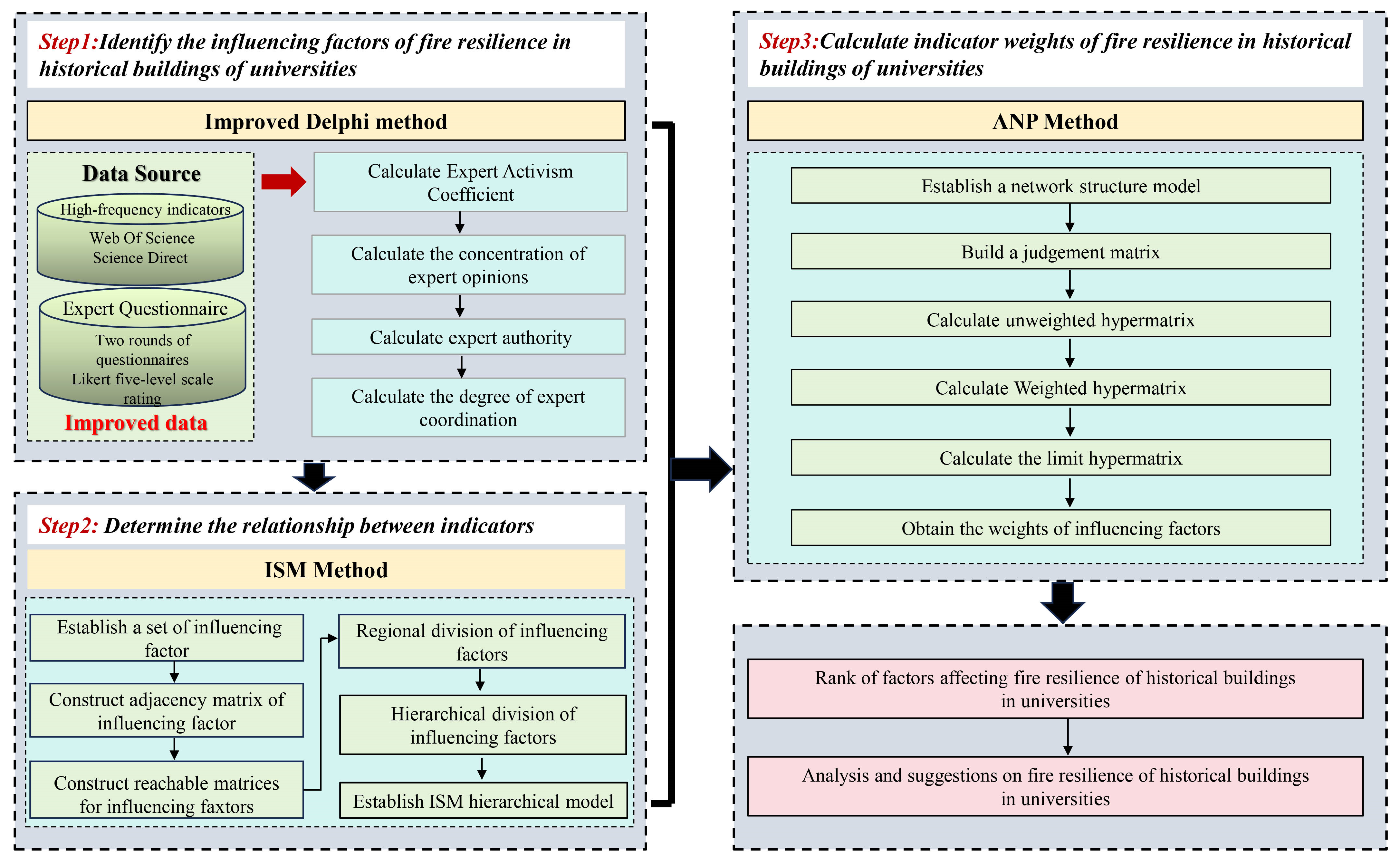
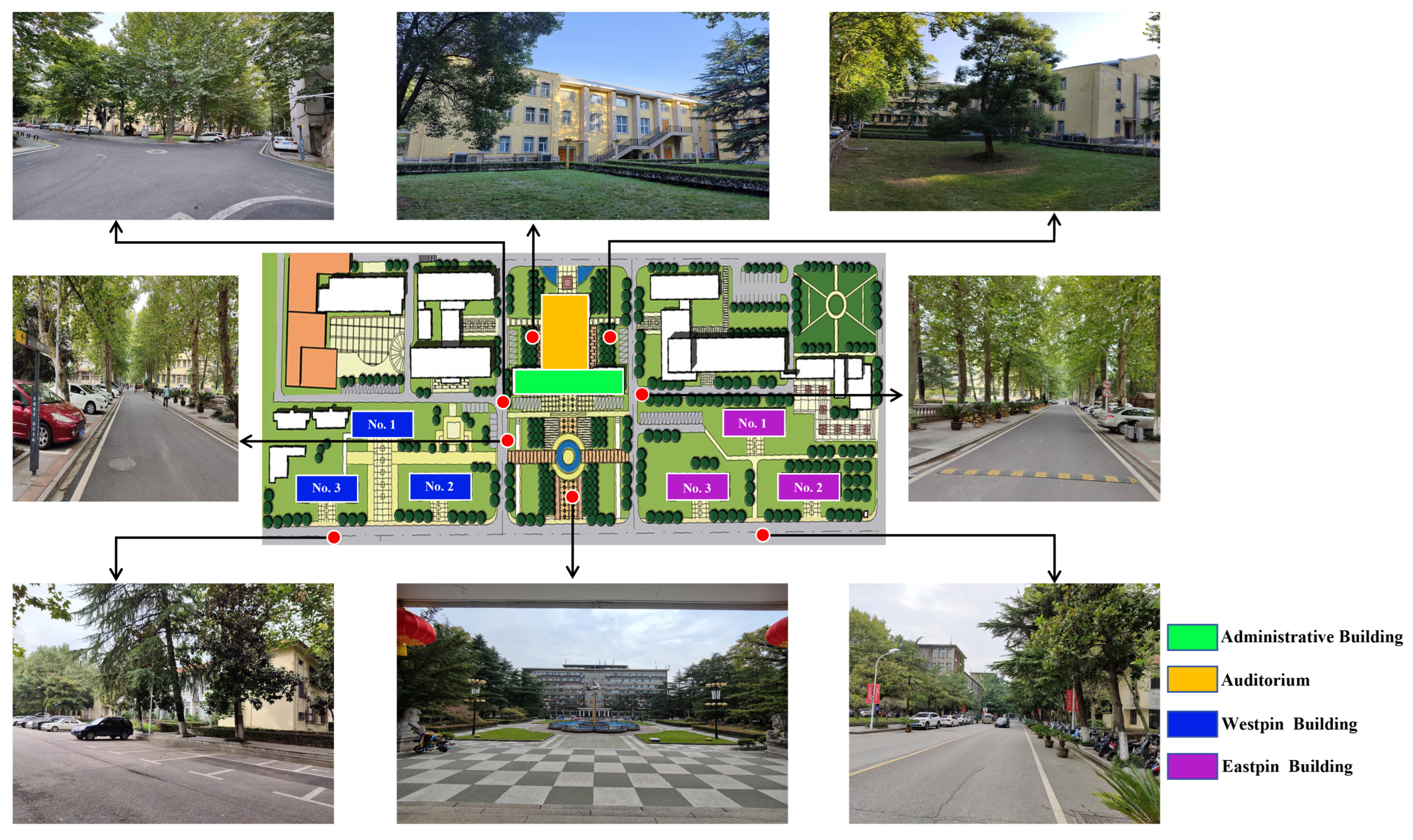
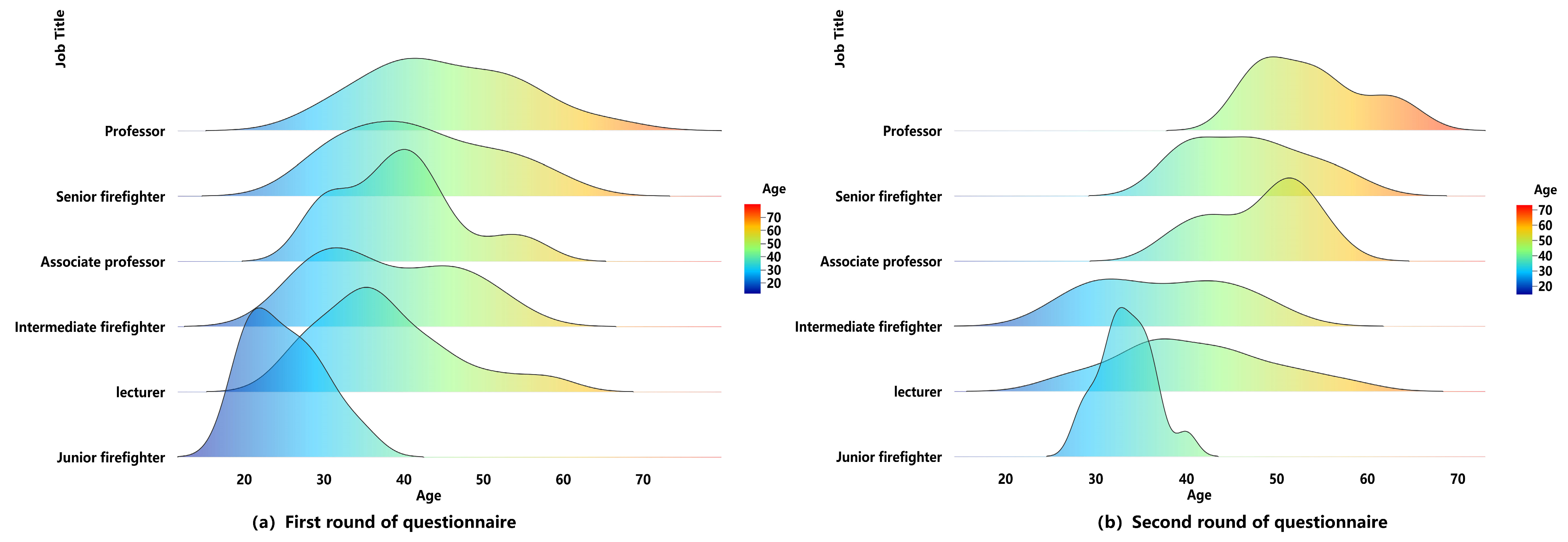
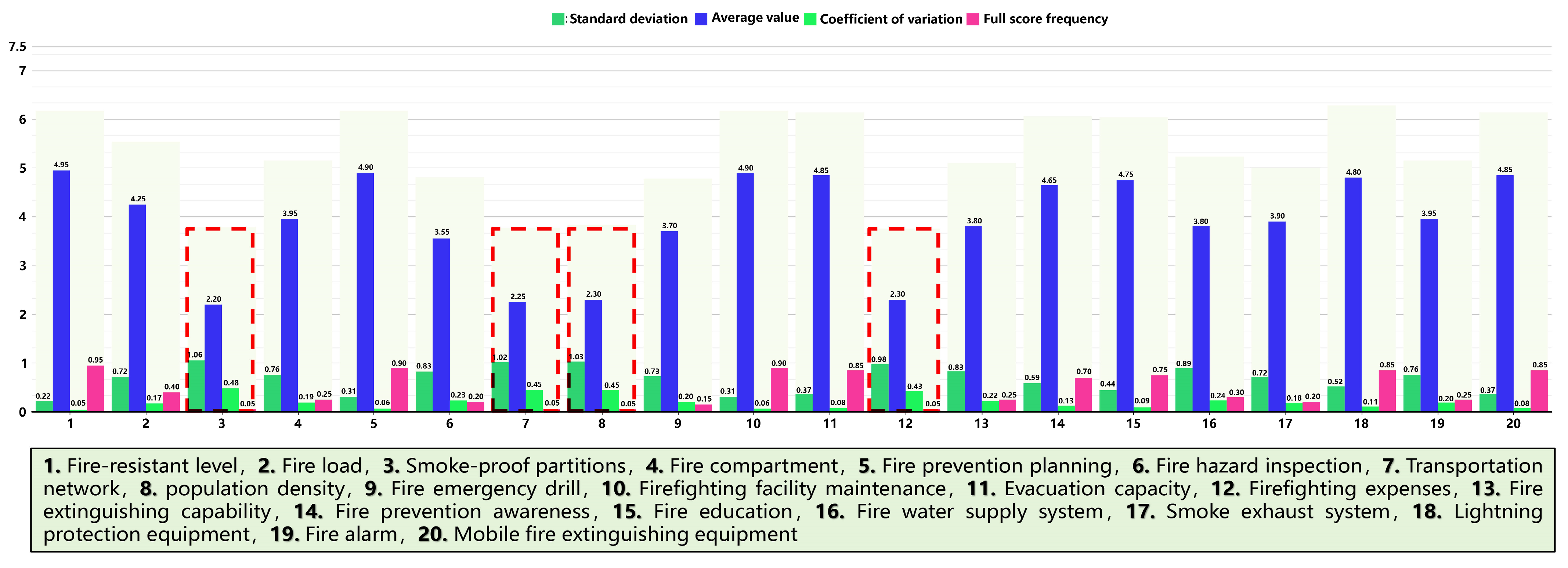
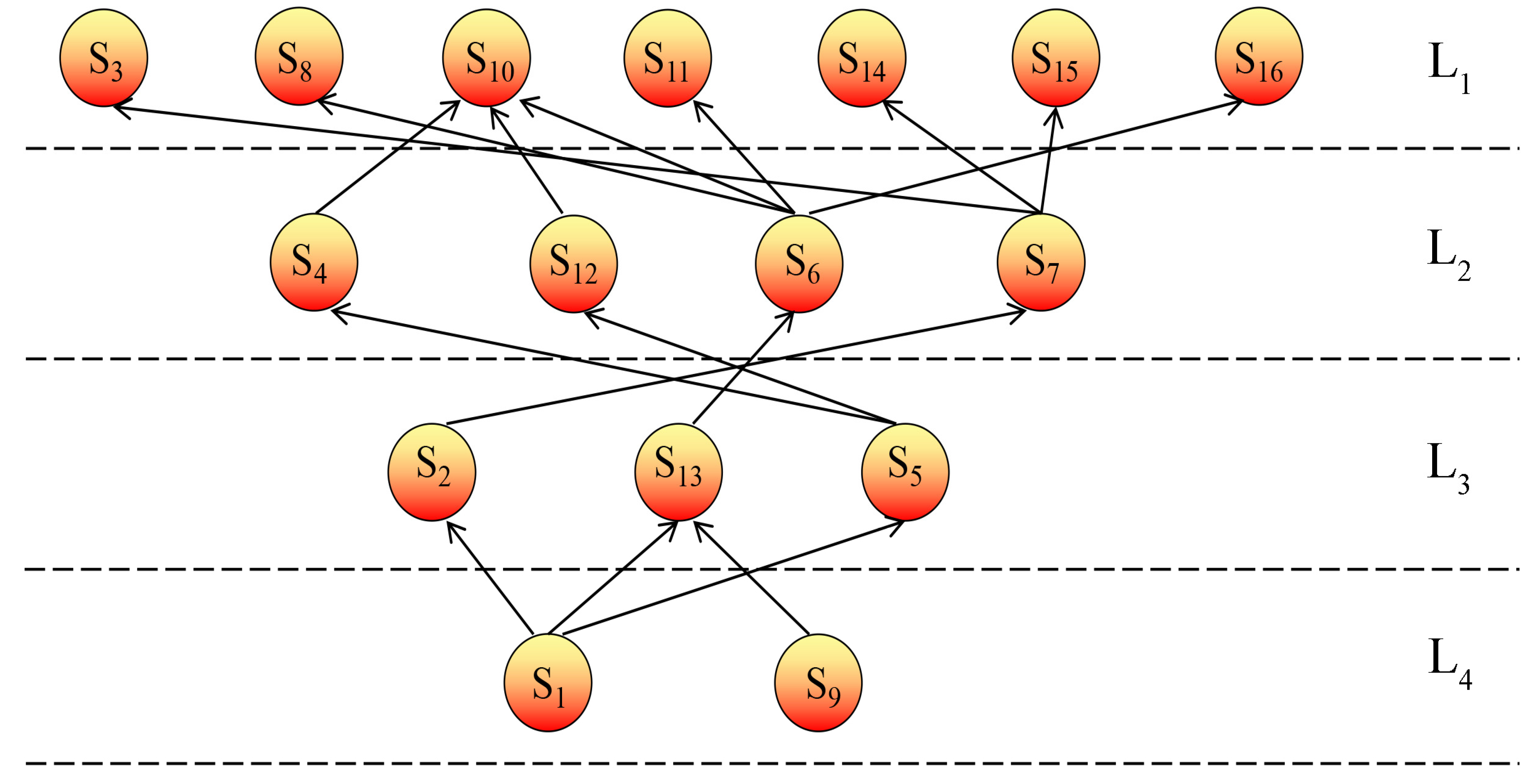
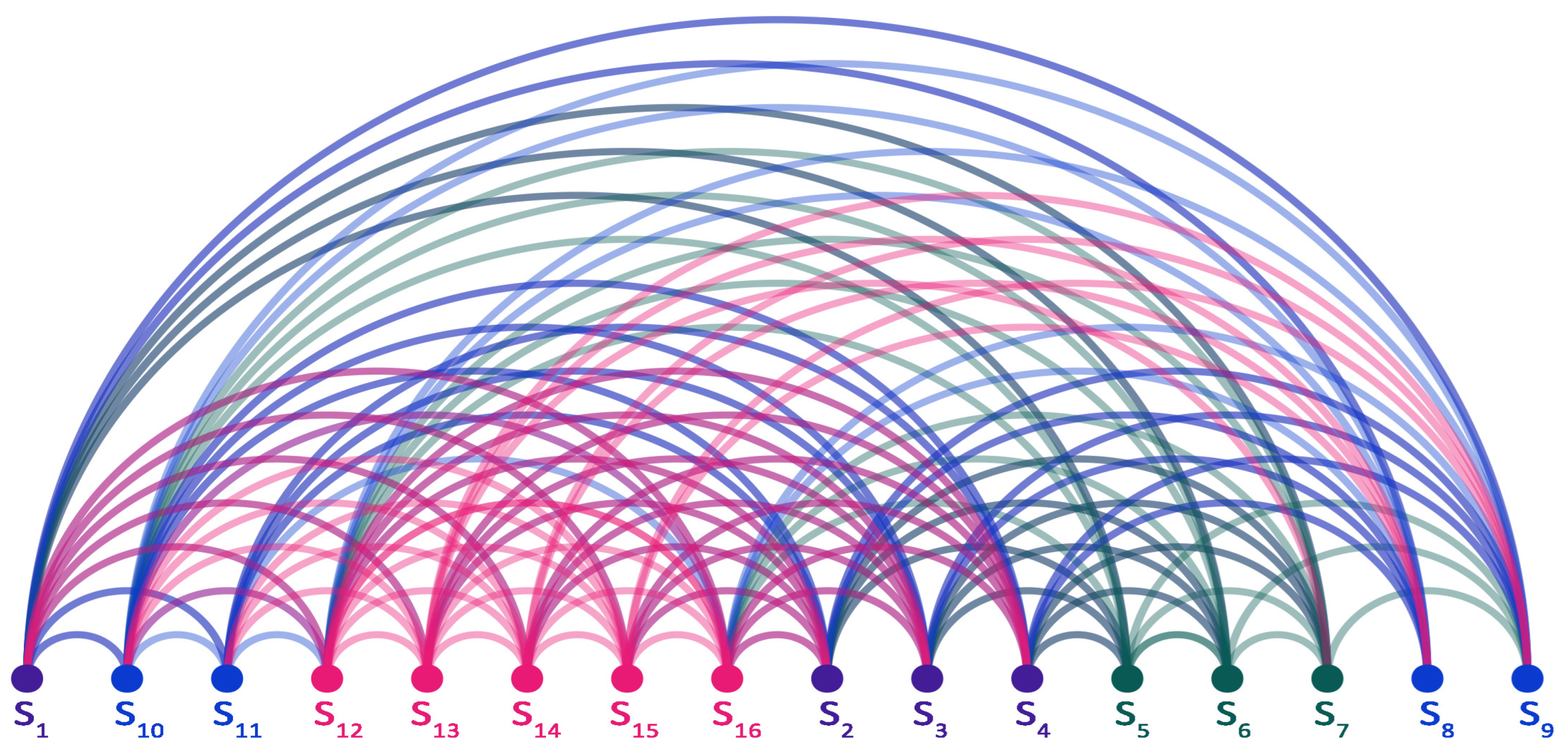
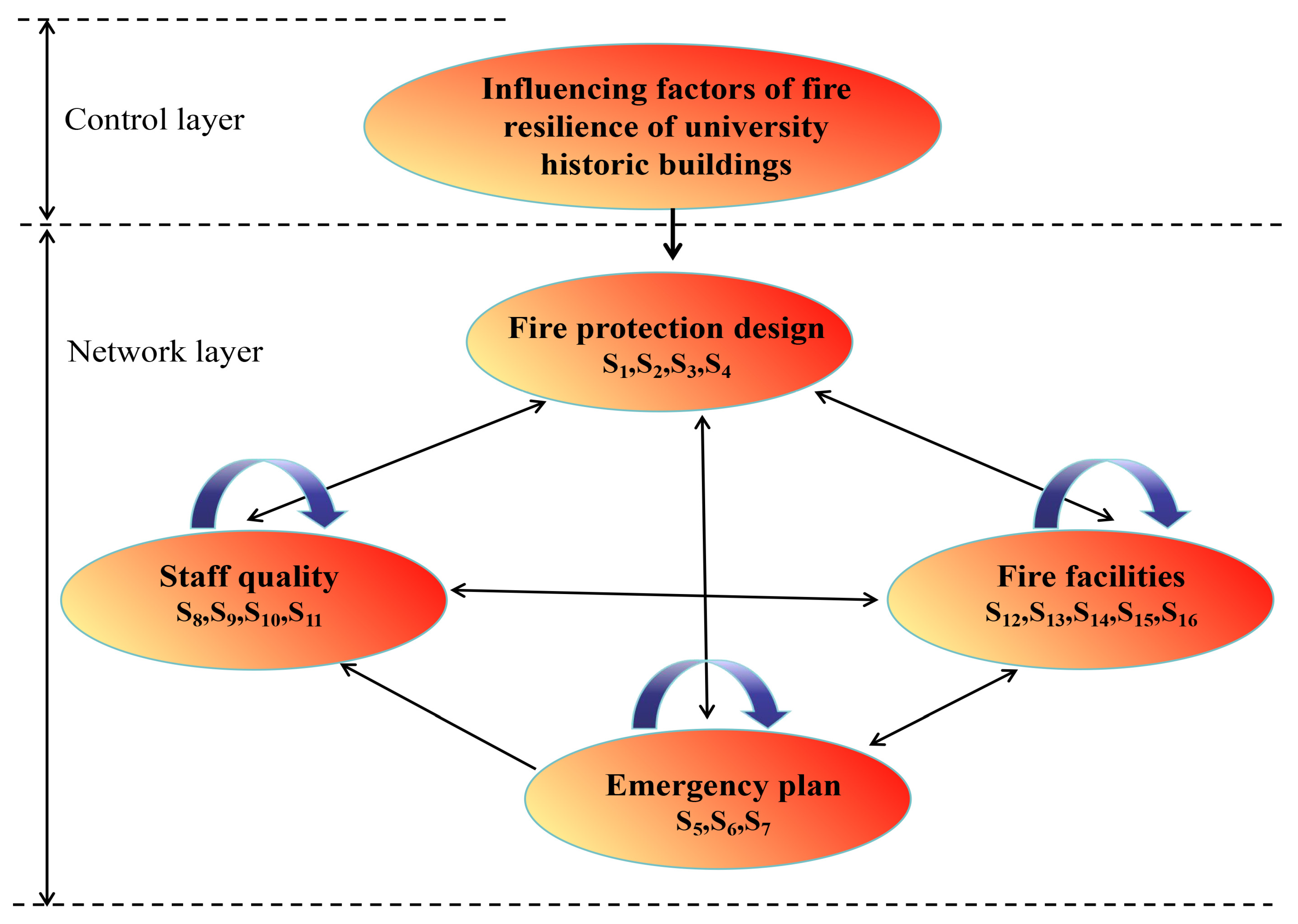
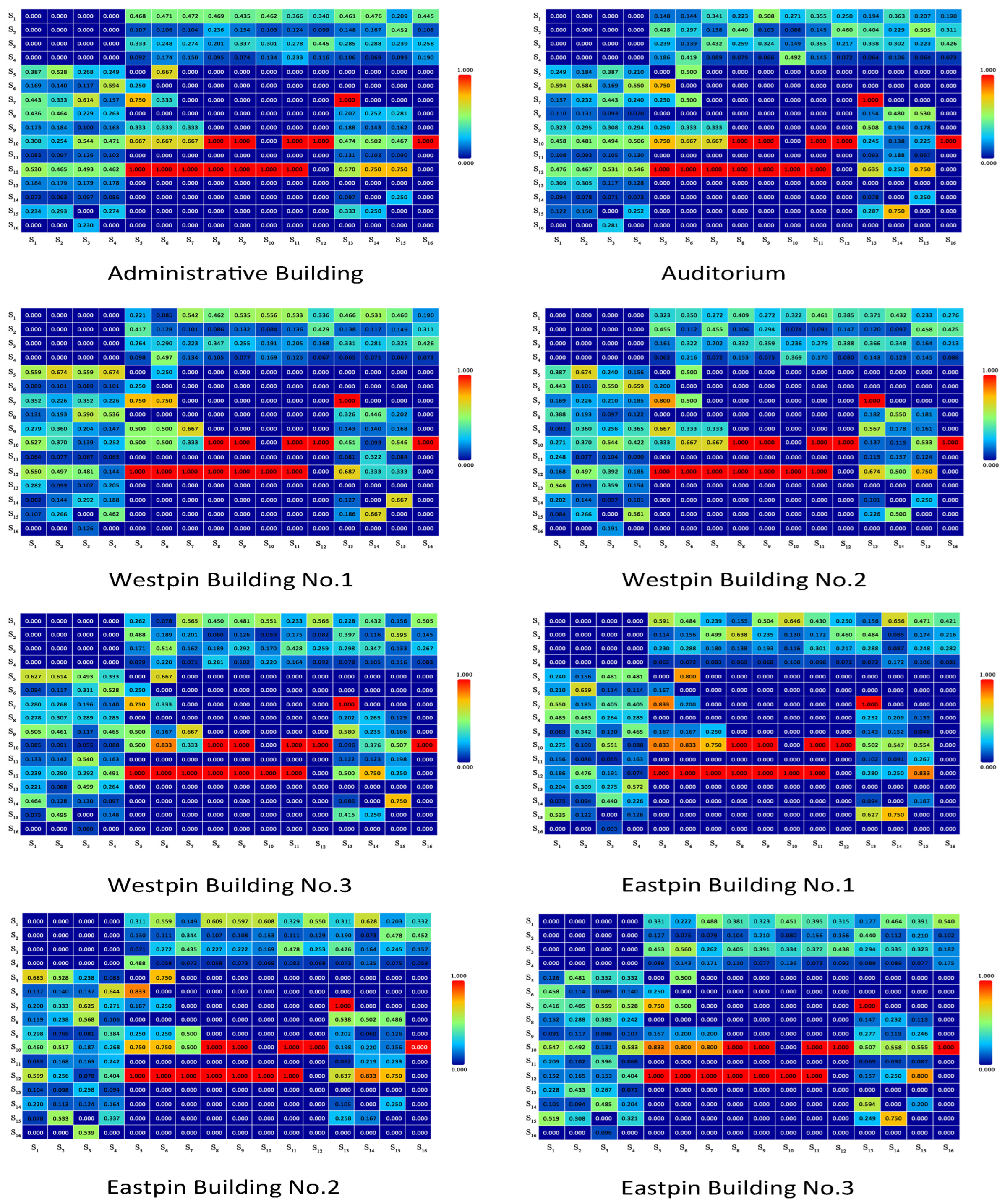
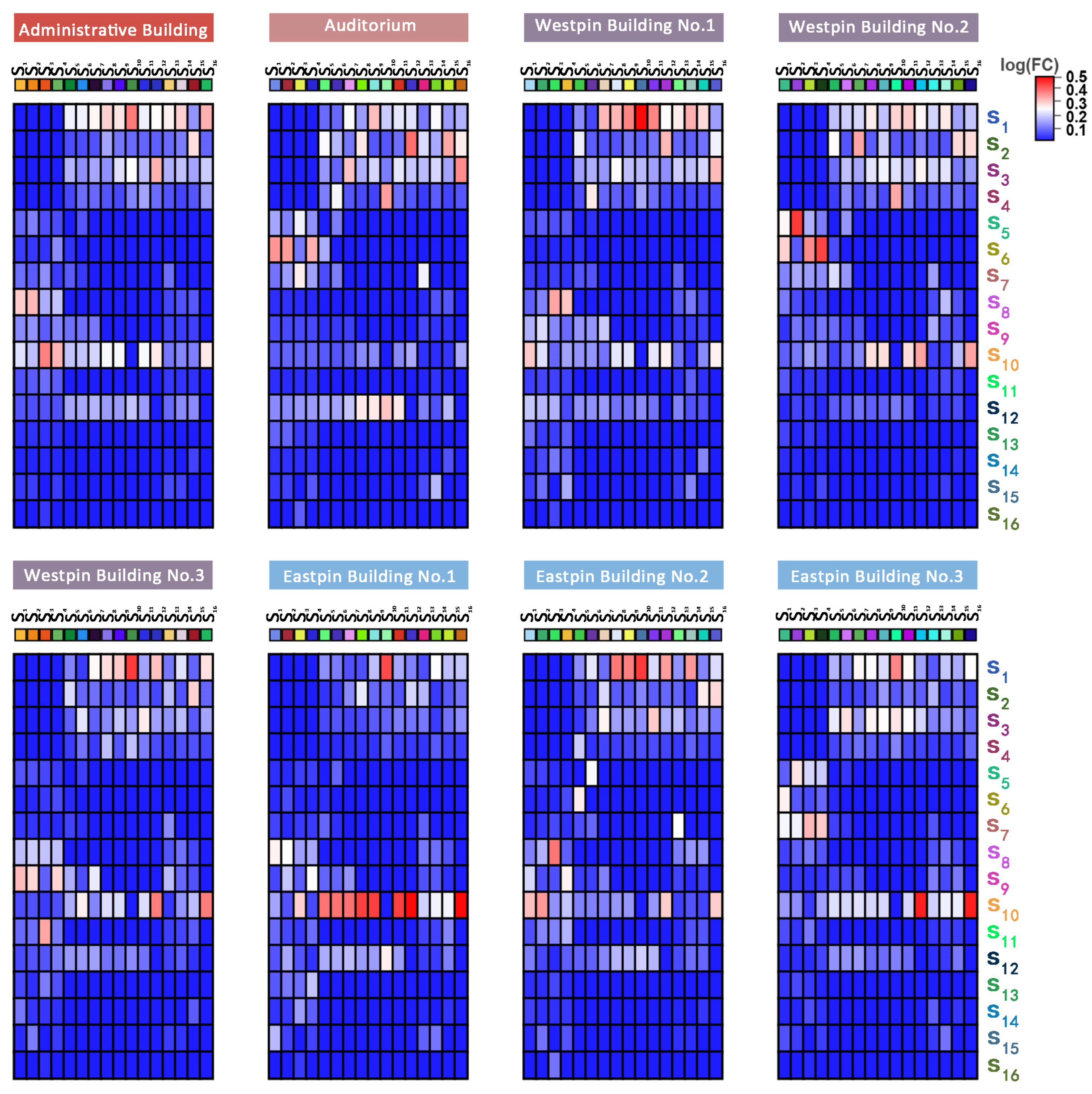
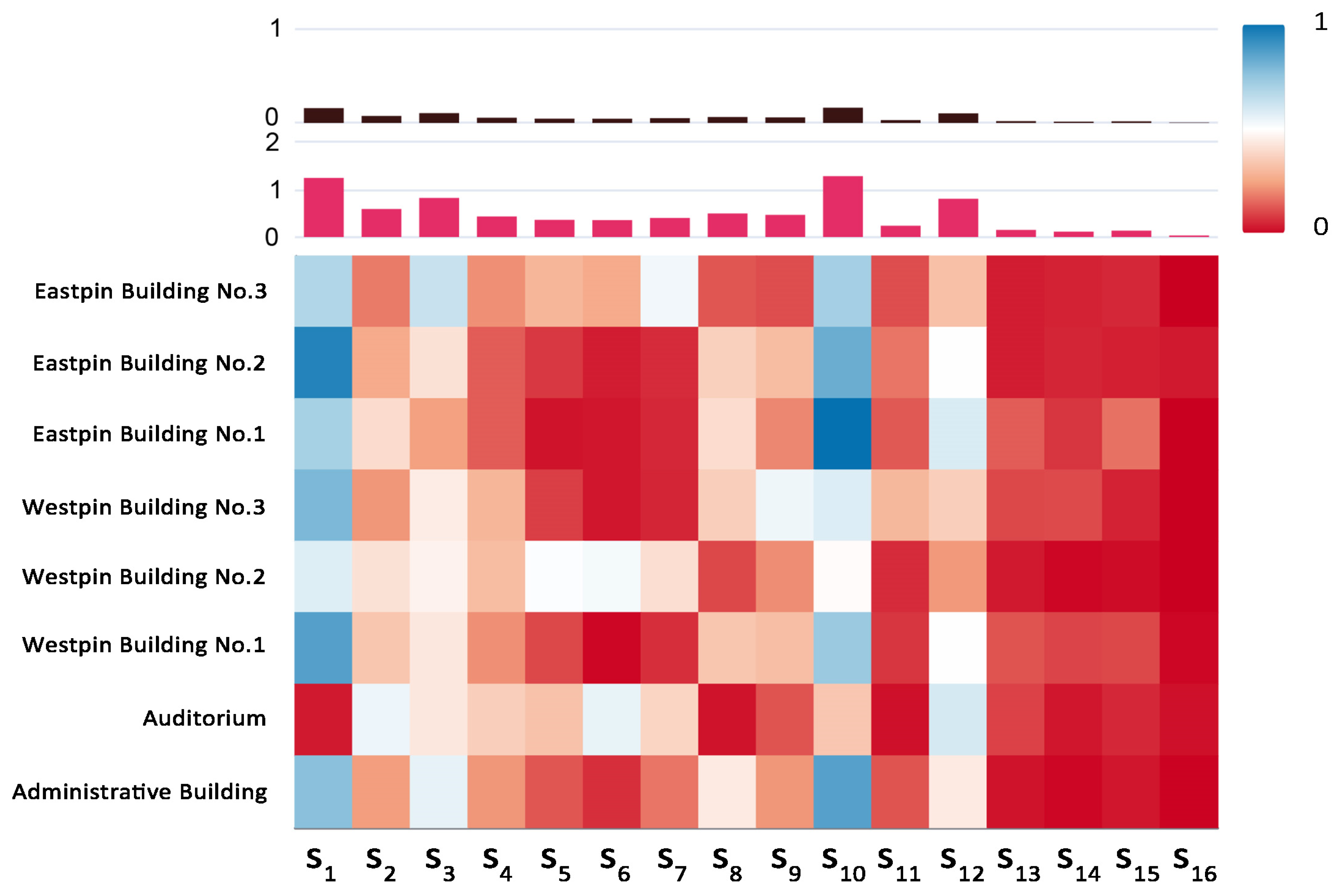
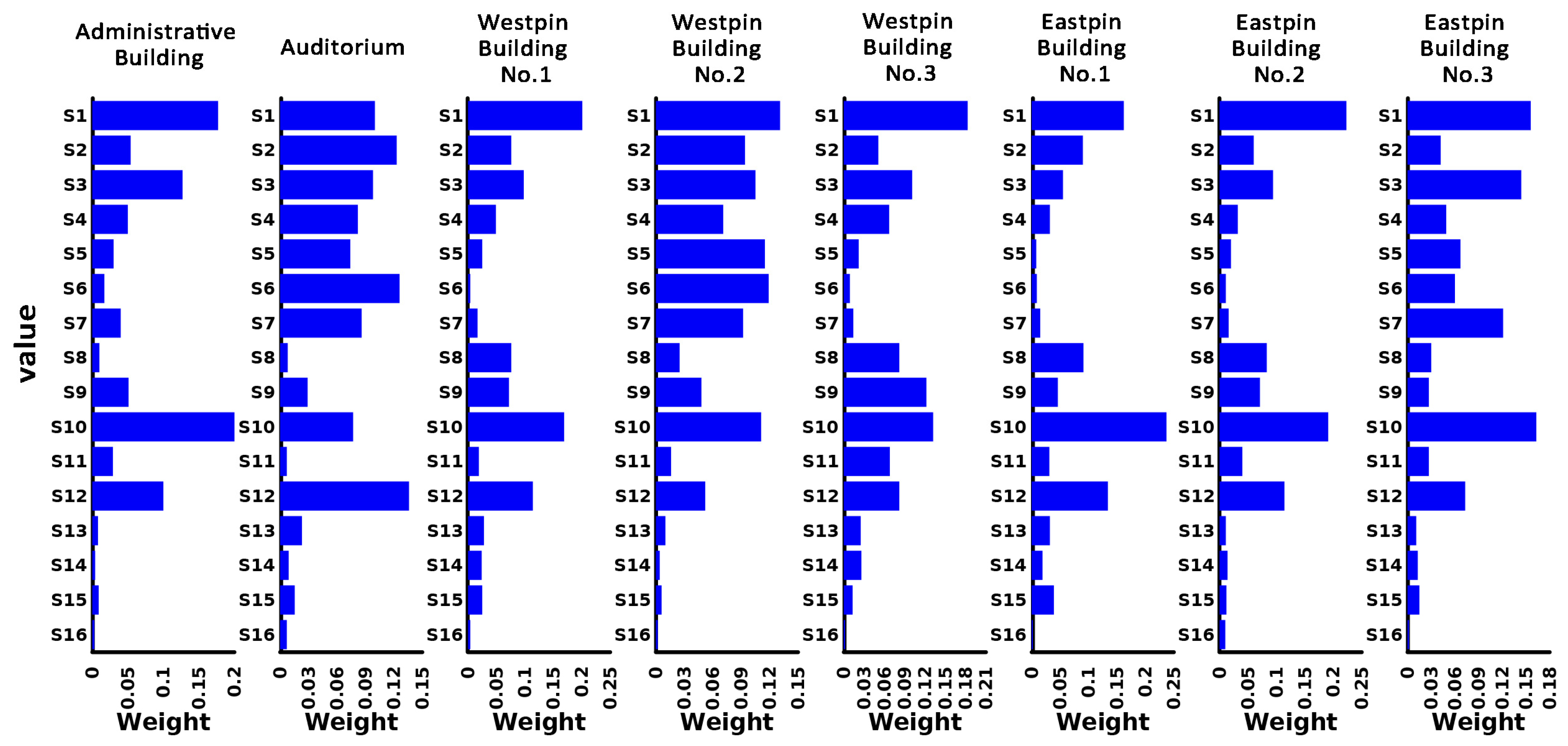
| Architecture | Number of Floors | Original Function | Current Functions |
|---|---|---|---|
| Administration Building | 4 | Administration building | Administration |
| Auditorium | 2 | Cinema | Ceremonies |
| Westpin Building No. 1 | 2 | Teaching building | Graduate School |
| Westpin Building No. 2 | 2 | Teaching building | Thermo-electromagnetic Energy Conversion Technology Center/Thermo-electromagnetic Materials and Devices Laboratory |
| Westpin Building No. 3 | 2 | Teaching building | Personnel department/State-owned assets and laboratory management department |
| Eastpin Building No. 1 | 2 | Teaching building | Nanotechnology Key Laboratory |
| Eastpin Building No. 2 | 2 | Teaching building | Biocomposite Materials Laboratory |
| Eastpin Building No. 3 | 2 | Teaching building | Intelligent Materials and Devices Research Center |
| Architecture | Indoor Environment | External Environment | Fire Node |
|---|---|---|---|
| Administration Building |  | 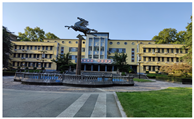 | 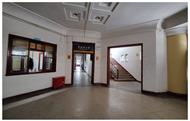 |
| Auditorium | 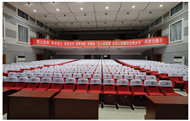 | 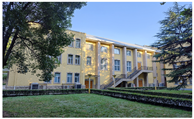 | 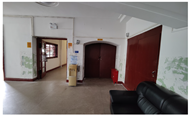 |
| Westpin Building No. 1 |  |  | 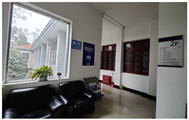 |
| Westpin Building No. 2 | 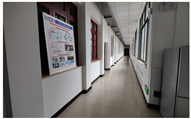 | 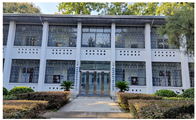 |  |
| Westpin Building No. 3 | 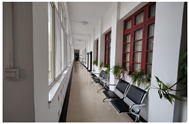 | 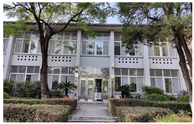 | 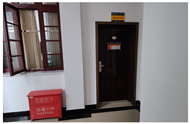 |
| Eastpin Building No. 1 | 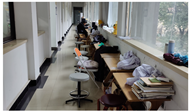 | 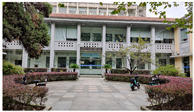 | 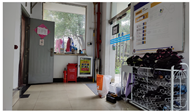 |
| Eastpin Building No. 2 | 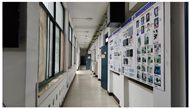 | 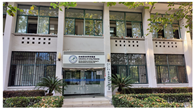 |  |
| Eastpin Building No. 3 | 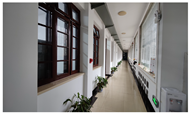 |  | 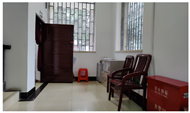 |
| Sjl | Normalized Eigenvector | |
|---|---|---|
| Si1 | S11, S12,…, S1n | |
| Si2 | S21, S22,…, S2n | |
| ⋮ | ⋮ | |
| Sini | Sn1, Sn2,…, Snn |
| Relative Importance | Definition | Interpretation |
|---|---|---|
| 1 | Equally important | i and j are equally important |
| 3 | Slightly important | i is slightly more important than j |
| 5 | Quite important | i is much more important than j |
| 7 | Clearly important | i is obviously more important than j |
| 9 | Absolutely important | i is definitely more important than j |
| 2, 4, 6, 8 | Between adjacent importance levels | The middle value of the two adjacent importance levels |
| Order | 2 | 3 | 4 | 5 | 6 | 7 | 8 | 9 | 10 | 11 | 12 |
|---|---|---|---|---|---|---|---|---|---|---|---|
| RI | 0 | 0.52 | 0.89 | 1.12 | 1.26 | 1.36 | 1.41 | 1.46 | 1.49 | 1.52 | 1.54 |
| Sj | Si1 Si2 … SN | Normalized Eigenvector |
|---|---|---|
| S1 | m1j | |
| S2 | m2j | |
| ⋮ | ⋮ | |
| SN | mNj |
| Number of Times | Quantity Issued | Recycling Quantity | Expert Positivity Coefficient |
|---|---|---|---|
| First round | 100 | 96 | 96% |
| Second round | 105 | 102 | 97% |
| Expert Features | n (96) | % | n (102) | % | |
|---|---|---|---|---|---|
| Experience | Up to 5 years | 33 | 34.4% | 31 | 30.6% |
| 5–10 years | 25 | 26% | 22 | 21.4% | |
| More than 10 years | 38 | 39.6% | 49 | 48% | |
| Expertise in | Fire resilience | 22 | 22.9% | 27 | 26.5% |
| Fire Management | 48 | 50% | 45 | 43.9% | |
| Historical Building Management | 26 | 27.1% | 30 | 29.6% | |
| Job position | Academician | 31 | 33.3% | 34 | 33.7% |
| Fire officers and soldiers | 48 | 50% | 51 | 50% | |
| Municipal managers | 17 | 17.7% | 17 | 16.3% | |
| Review Content | Mean Range (First Round) | Mean Range (Second Round) |
|---|---|---|
| Evaluation Metrics | 0.6 | 0.8 |
| Degree of Understanding | Unfamiliar | Not Very Familiar | General Familiarity | Familiar | Very Familiar |
|---|---|---|---|---|---|
| Number of people in the first round | 0 | 0 | 0 | 47 | 49 |
| Second round of numbers | 0 | 0 | 0 | 50 | 52 |
| Expert familiarity weight | 0.2 | 0.4 | 0.6 | 0.8 | 1 |
| Judgment Basis | Large | Medium | Small | Fraction | |||
|---|---|---|---|---|---|---|---|
| Number | Assignment | Number | Assignment | Number | Assignment | ||
| Practical experience | 51 | 0.5 | 45 | 0.4 | 0 | 0.3 | 0.45 |
| Theoretical analysis | 50 | 0.3 | 46 | 0.2 | 0 | 0.1 | 0.25 |
| Learn from colleagues at home and abroad | 0 | 0.1 | 49 | 0.1 | 47 | 0.1 | 0.1 |
| Intuition | 0 | 0.1 | 84 | 0.1 | 12 | 0.1 | 0.1 |
| Judgment Basis | Large | Medium | Small | Fraction | |||
|---|---|---|---|---|---|---|---|
| Number | Assignment | Number | Assignment | Number | Assignment | ||
| Practical experience | 58 | 0.5 | 44 | 0.4 | 0 | 0.3 | 0.46 |
| Theoretical analysis | 45 | 0.3 | 57 | 0.2 | 0 | 0.1 | 0.24 |
| Learn from colleagues at home and abroad | 0 | 0.1 | 54 | 0.1 | 48 | 0.1 | 0.1 |
| Intuition | 0 | 0.1 | 85 | 0.1 | 17 | 0.1 | 0.1 |
| Questionnaire | Coefficient of Variation | Coordination Coefficient | Chi-Square Value | Degrees of Freedom | H Value |
|---|---|---|---|---|---|
| First round | 0–0.4802 | 0.623 | 236.193 | 18 | <0.0001 |
| Second round | 0–0.2139 | 0.651 | 194.952 | 16 | <0.0001 |
| Index | Standard Deviation | Average Value | Coefficient of Variation | Full Score Frequency |
|---|---|---|---|---|
| Fire resistance level | 0.2236 | 4.95 | 0.0452 | 0.95 |
| Fire load | 0.7327 | 3.70 | 0.198 | 0.15 |
| Fire compartment | 0.7592 | 3.95 | 0.1922 | 0.25 |
| Fire prevention planning | 0.7164 | 3.75 | 0.1910 | 0.15 |
| Fire hazard inspection | 0.2236 | 4.95 | 0.0452 | 0.95 |
| Fire emergency drill | 0.6959 | 3.80 | 0.1831 | 0.15 |
| Firefighting facility maintenance | 0.3078 | 4.90 | 0.0628 | 0.90 |
| Evacuation capacity | 0.7678 | 3.80 | 0.2020 | 0.20 |
| Fire extinguishing capability | 0.3663 | 4.85 | 0.0755 | 0.85 |
| Fire prevention awareness | 0.7592 | 3.55 | 0.2138 | 0.15 |
| Fire education | 0.2236 | 4.95 | 0.0452 | 0.95 |
| Fire water supply system | 0.7452 | 3.65 | 0.2042 | 0.15 |
| Smoke exhaust system | 0.8256 | 3.55 | 0.2326 | 0.20 |
| Lightning protection equipment | 0.7539 | 3.60 | 0.2094 | 0.15 |
| Fire alarm | 0.8335 | 3.80 | 0.2193 | 0.25 |
| Mobile fire extinguishing equipment | 0.6156 | 3.80 | 0.1620 | 0.10 |
| Scheme | Index | Description | Symbol |
|---|---|---|---|
| Fire protection design | Fire resistant level | Grading scale that measures the fire resistance of a building | S1 |
| Fire load | Parameter that measures the amount of combustible materials contained in a building | S2 | |
| Fire compartment | Fire compartments are areas separated by fire walls, floors, fire doors, or fire curtains | S3 | |
| Fire prevention planning | The extent to which the functional layout of the campus meets the needs of the fire safety layout | S4 | |
| Emergency plan | Fire hazard inspection | The risk of fire can be effectively reduced via regular inspection and rectification | S5 |
| Fire emergency drill | An emergency plan was formulated to address sudden fire accidents | S6 | |
| Firefighting facility maintenance | Conduct inspection and testing on various systems of building fire protection facilities to determine whether these facilities meet the specifications | S7 | |
| Staff quality | Evacuation capacity | Evacuation time for teachers and students to leave the danger zone | S8 |
| Fire extinguishing capability | Whether teachers and students can arrive at a scene as soon as possible to participate in firefighting and rescue | S9 | |
| Fire prevention awareness | Knowledge and awareness of fire safety and firefighting | S10 | |
| Fire education | Through education, teachers and students can understand the hazards and preventive measures of fire to improve their self-rescue abilities in case of fire | S11 | |
| Fire facilities | Fire water supply system | Includes indoor and outdoor fire water supply facilities, that are designed to provide a stable and reliable water source to respond to emergencies, such as fires | S12 |
| Smoke exhaust system | Comprises air supply and exhaust ducts, pipe wells, fire dampers, door switch equipment, supply and exhaust fans, etc. | S13 | |
| Lightning protection equipment | Equipment that is protected from lightning strikes by modern electrical and other technologies | S14 | |
| Fire alarm | Helps people find early-stage fires and take effective measures | S15 | |
| Mobile fire extinguishing equipment | Portable firefighting tool that can be used to quickly put out a fire | S16 |
| Influencing Factors Si | Reachable Set (Ri) | Advance Set (Ai) | Common Set C(Si) | Beginning Set B(Si) | Termination Set E(Si) |
|---|---|---|---|---|---|
| S1 | 1, 2, 3, 4, 5, 6, 7, 8, 9, 10, 11, 12, 13, 14, 15, 16 | 1 | S1 | √ | |
| S2 | 2, 3, 7, 10, 14, 15 | 1, 2, 9 | S2 | ||
| S3 | 3 | 1, 2, 3, 7, 9, 13 | S3 | √ | |
| S4 | 4, 10 | 1, 4, 5, 9, 13 | S4 | ||
| S5 | 4, 5, 8, 10, 12 | 1, 5, 9 | S5 | ||
| S6 | 6, 8, 10, 11, 16 | 1, 6, 9, 13 | S6 | ||
| S7 | 3, 7, 10, 14, 15 | 1, 2, 7, 9 | S7 | ||
| S8 | 8 | 1, 5, 6, 8, 9, 13 | S8 | √ | |
| S9 | 1, 2, 3, 4, 5, 6, 7, 8, 9, 10, 11, 12, 13, 14, 15, 16 | 9 | S9 | √ | |
| S10 | 10 | 1, 2, 4, 5, 6, 7, 9, 10, 12, 13 | S10 | √ | |
| S11 | 11 | 1, 6, 9, 11, 13 | S11 | √ | |
| S12 | 10, 12 | 1, 5, 9, 12 | S12 | ||
| S13 | 3, 4, 6, 8, 10, 11, 13, 16 | 1, 9, 13 | S13 | ||
| S14 | 14 | 1, 2, 7, 9, 14 | S14 | √ | |
| S15 | 15 | 1, 2, 7, 9, 15 | S15 | √ | |
| S16 | 16 | 1, 6, 9, 13, 16 | S16 | √ |
Disclaimer/Publisher’s Note: The statements, opinions and data contained in all publications are solely those of the individual author(s) and contributor(s) and not of MDPI and/or the editor(s). MDPI and/or the editor(s) disclaim responsibility for any injury to people or property resulting from any ideas, methods, instructions or products referred to in the content. |
© 2025 by the authors. Licensee MDPI, Basel, Switzerland. This article is an open access article distributed under the terms and conditions of the Creative Commons Attribution (CC BY) license (https://creativecommons.org/licenses/by/4.0/).
Share and Cite
Huang, B.; Wang, J.; Yuan, C. Fire Resilience Evaluation of a Historic University Building in China. Appl. Sci. 2025, 15, 9131. https://doi.org/10.3390/app15169131
Huang B, Wang J, Yuan C. Fire Resilience Evaluation of a Historic University Building in China. Applied Sciences. 2025; 15(16):9131. https://doi.org/10.3390/app15169131
Chicago/Turabian StyleHuang, Bo, Junwu Wang, and Chunbao Yuan. 2025. "Fire Resilience Evaluation of a Historic University Building in China" Applied Sciences 15, no. 16: 9131. https://doi.org/10.3390/app15169131
APA StyleHuang, B., Wang, J., & Yuan, C. (2025). Fire Resilience Evaluation of a Historic University Building in China. Applied Sciences, 15(16), 9131. https://doi.org/10.3390/app15169131










